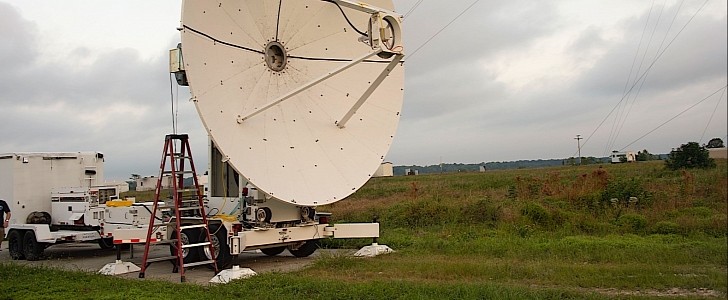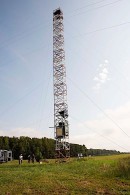Imagine a future when our technology functions not by using energy gained through the burning of fuel, the use of batteries, or the stretching of miles of cables. A future when energy can be beamed directly to the hardware in need of it. A future that, for better or worse, has probably already started.
Beaming energy has been a constant preoccupation of sci-fi authors, and in imagination land, it often works like a charm. Here in the real world though, we’re just beginning to scratch the surface of what is possible.
This week, the U.S. Navy announced something it calls the “most significant power beaming demonstration in nearly 50 years.” It saw a team of researchers from the U.S. Naval Research Laboratory shoot 1.6 kilowatts of power via a microwave dish transmitter, with the beam hitting an adapted receiver antenna located 0.6 miles away (1 km).
It was the culmination of a number of tests that took place over the past 12 months, at the U.S. Army Research Field at Blossom Point in Maryland and at MIT’s The Haystack Ultrawideband Satellite Imaging Radar (HUSIR) transmitter in Massachusetts.
The team used a 10 gigahertz microwave beam, a frequency easily achievable because “component technology out there is cheap and mature” and, most importantly, does not lose more than 5 percent of its power, even in heavy rain.
Described as the “point-to-point transfer of electrical energy across free space by a directive microwave beam,” this type of energy beaming is of particular interest for the American military, which is looking for ways to eventually beam down energy from space, thus mitigating “the reliance on the fuel supply for troops, which can be vulnerable to attack.”
Best of all, this technique is also safe and completely green, as in it does not harm creatures, and can be generated and supplied around the clock.
The recently announced test is part of the Navy’s Safe and COntinuous Power bEaming – Microwave (SCOPE-M) project. No info was provided on what comes next for this research.
This week, the U.S. Navy announced something it calls the “most significant power beaming demonstration in nearly 50 years.” It saw a team of researchers from the U.S. Naval Research Laboratory shoot 1.6 kilowatts of power via a microwave dish transmitter, with the beam hitting an adapted receiver antenna located 0.6 miles away (1 km).
It was the culmination of a number of tests that took place over the past 12 months, at the U.S. Army Research Field at Blossom Point in Maryland and at MIT’s The Haystack Ultrawideband Satellite Imaging Radar (HUSIR) transmitter in Massachusetts.
The team used a 10 gigahertz microwave beam, a frequency easily achievable because “component technology out there is cheap and mature” and, most importantly, does not lose more than 5 percent of its power, even in heavy rain.
Described as the “point-to-point transfer of electrical energy across free space by a directive microwave beam,” this type of energy beaming is of particular interest for the American military, which is looking for ways to eventually beam down energy from space, thus mitigating “the reliance on the fuel supply for troops, which can be vulnerable to attack.”
Best of all, this technique is also safe and completely green, as in it does not harm creatures, and can be generated and supplied around the clock.
The recently announced test is part of the Navy’s Safe and COntinuous Power bEaming – Microwave (SCOPE-M) project. No info was provided on what comes next for this research.




